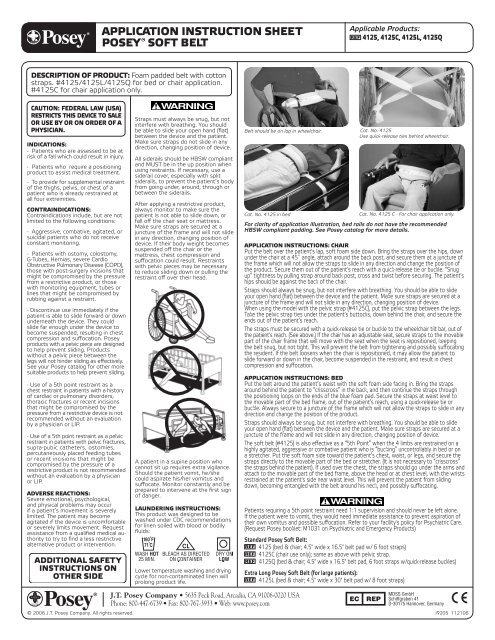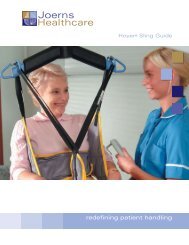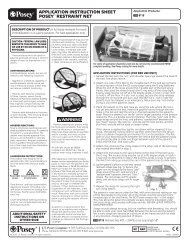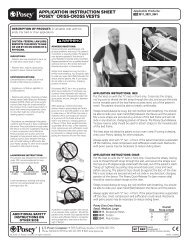APPLICATION INSTRUCTION SHEET POSEY® SOFT ... - Rehabmart
APPLICATION INSTRUCTION SHEET POSEY® SOFT ... - Rehabmart
APPLICATION INSTRUCTION SHEET POSEY® SOFT ... - Rehabmart
You also want an ePaper? Increase the reach of your titles
YUMPU automatically turns print PDFs into web optimized ePapers that Google loves.
DESCRIPTION OF PRODUCT: Foam padded belt with cotton<br />
straps. #4125/4125L/4125Q for bed or chair application.<br />
#4125C for chair application only.<br />
CAUTION: FEDERAL LAW (USA)<br />
RESTRICTS THIS DEVICE TO SALE<br />
OR USE BY OR ON ORDER OF A<br />
PHYSICIAN.<br />
INDICATIONS:<br />
- Patients who are assessed to be at<br />
risk of a fall which could result in injury.<br />
- Patients who require a positioning<br />
product to assist medical treatment.<br />
- To provide for supplemental restraint<br />
of the thighs, pelvis, or chest of a<br />
patient who is already restrained at<br />
all four extremities.<br />
CONTRAINDICATIONS:<br />
Contraindications include, but are not<br />
limited to the following conditions:<br />
- Aggressive, combative, agitated, or<br />
suicidal patients who do not receive<br />
constant monitoring.<br />
- Patients with ostomy, colostomy,<br />
G-Tubes, Hernias, severe Cardio<br />
Obstructive Pulmonary Disease (COPD),<br />
those with post-surgery incisions that<br />
might be compromised by the pressure<br />
from a restrictive product, or those<br />
with monitoring equipment, tubes or<br />
lines that might be compromised by<br />
rubbing against a restraint.<br />
- Discontinue use immediately if the<br />
patient is able to slide forward or down<br />
underneath the device. They could<br />
slide far enough under the device to<br />
become suspended, resulting in chest<br />
compression and suffocation. Posey<br />
products with a pelvic piece are designed<br />
to help prevent sliding. Products<br />
without a pelvic piece between the<br />
legs will not hinder sliding as effectively.<br />
See your Posey catalog for other more<br />
suitable products to help prevent sliding.<br />
- Use of a 5th point restraint as a<br />
chest restraint in patients with a history<br />
of cardiac or pulmonary disorders,<br />
thoracic fractures or recent incisions<br />
that might be compromised by the<br />
pressure from a restrictive device is not<br />
recommended without an evaluation<br />
by a physician or LIP.<br />
- Use of a 5th point restraint as a pelvic<br />
restraint in patients with pelvic fractures,<br />
supra-pubic catheters, ostomies,<br />
percutaneously placed feeding tubes<br />
or recent incisions that might be<br />
compromised by the pressure of a<br />
restrictive product is not recommended<br />
without an evaluation by a physician<br />
or LIP.<br />
ADVERSE REACTIONS:<br />
Severe emotional, psychological,<br />
and physical problems may occur<br />
if a patient’s movement is severely<br />
limited. The patient may become<br />
agitated if the device is uncomfortable<br />
or severely limits movement. Request<br />
assistance from a qualified medical authority<br />
to try to find a less restrictive<br />
alternative product or intervention.<br />
ADDITIONAL SAFETY<br />
<strong>INSTRUCTION</strong>S ON<br />
OTHER SIDE<br />
<strong>APPLICATION</strong> <strong>INSTRUCTION</strong> <strong>SHEET</strong><br />
POSEY ® <strong>SOFT</strong> BELT<br />
Straps must always be snug, but not<br />
interfere with breathing. You should<br />
be able to slide your open hand (flat)<br />
between the device and the patient.<br />
Make sure straps do not slide in any<br />
direction, changing position of device.<br />
All siderails should be HBSW compliant<br />
and MUST be in the up position when<br />
using restraints. If necessary, use a<br />
siderail cover, especially with split<br />
siderails, to prevent the patient’s body<br />
from going under, around, through or<br />
between the siderails.<br />
After applying a restrictive product,<br />
always monitor to make sure the<br />
patient is not able to slide down, or<br />
fall off the chair seat or mattress.<br />
Make sure straps are secured at a<br />
juncture of the frame and will not slide<br />
in any direction, changing position of<br />
device. If their body weight becomes<br />
suspended off the chair or the<br />
mattress, chest compression and<br />
suffocation could result. Restraints<br />
with pelvic pieces may be necessary<br />
to reduce sliding down or pulling the<br />
restraint off over their head.<br />
A patient in a supine position who<br />
cannot sit up requires extra vigilance.<br />
Should the patient vomit, he/she<br />
could aspirate his/her vomitus and<br />
suffocate. Monitor constantly and be<br />
prepared to intervene at the first sign<br />
of danger.<br />
LAUNDERINg <strong>INSTRUCTION</strong>S:<br />
This product was designed to be<br />
washed under CDC recommendations<br />
for linen soiled with blood or bodily<br />
fluids:<br />
Lower temperature washing and drying<br />
cycle for non-contaminated linen will<br />
prolong product life.<br />
Belt should be on lap in wheelchair.<br />
Cat. No. 4125 in bed<br />
J.T. Posey Company • 5635 Peck Road, Arcadia, CA 91006-0020 USA<br />
Phone: 800-447-6739 • Fax: 800-767-3933 • Web: www.posey.com<br />
Applicable Products:<br />
4125, 4125C, 4125L, 4125Q<br />
Cat. No. 4125<br />
Use quick-release ties behind wheelchair.<br />
<strong>APPLICATION</strong> <strong>INSTRUCTION</strong>S: CHAIR<br />
Put the belt over the patient's lap, soft foam side down. Bring the straps over the hips, down<br />
under the chair at a 45˚ angle, attach around the back post, and secure them at a juncture of<br />
the frame which will not allow the straps to slide in any direction and change the position of<br />
the product. Secure them out of the patient's reach with a quick-release tie or buckle. “Snug<br />
up” tightness by pulling strap around back post, cross and twist before securing. The patient's<br />
hips should be against the back of the chair.<br />
Straps should always be snug, but not interfere with breathing. You should be able to slide<br />
your open hand (flat) between the device and the patient. Make sure straps are secured at a<br />
juncture of the frame and will not slide in any direction, changing position of device. (Ref: 11A)<br />
When using the model with the pelvic strap (#4125C), put the pelvic strap between the legs.<br />
Take the pelvic strap ties under the patient's buttocks, down behind the chair, and secure the<br />
ends out of the patient’s reach.<br />
The straps must be secured with a quick-release tie or buckle to the wheelchair tilt bar, out of<br />
the patient's reach. (See above.) If the chair has an adjustable seat, secure straps to the movable<br />
part of the chair frame that will move with the seat when the seat is repositioned, keeping<br />
the belt snug, but not tight. This will prevent the belt from tightening and possibly suffocating<br />
the resident. If the belt loosens when the chair is repositioned, it may allow the patient to<br />
slide forward or down in the chair, become suspended in the restraint, and result in chest<br />
compression and suffocation.<br />
<strong>APPLICATION</strong> <strong>INSTRUCTION</strong>S: BED<br />
Put the belt around the patient’s waist with the soft foam side facing in. Bring the straps<br />
around behind the patient to “crisscross” in the back, and then continue the straps through<br />
the positioning loops on the ends of the blue foam pad. Secure the straps at waist level to<br />
the movable part of the bed frame, out of the patient’s reach, using a quick-release tie or<br />
buckle. Always secure to a juncture of the frame which will not allow the straps to slide in any<br />
direction and change the position of the product.<br />
Straps should always be snug, but not interfere with breathing. You should be able to slide<br />
your open hand (flat) between the device and the patient. Make sure straps are secured at a<br />
juncture of the frame and will not slide in any direction, changing position of device.<br />
The soft belt (#4125) is also effective as a “5th Point” when the 4 limbs are restrained on a<br />
highly agitated, aggressive or combative patient who is “bucking” uncontrollably in bed or on<br />
a stretcher. Put the soft foam side toward the patient’s chest, waist, or legs, and secure the<br />
straps directly to the movable part of the bed or stretcher. (It is not necessary to “crisscross”<br />
the straps behind the patient). If used over the chest, the straps should go under the arms and<br />
attach to the movable part of the bed frame, above the head or at chest level, with the wrists<br />
restrained at the patient's side near waist level. This will prevent the patient from sliding<br />
down, becoming entangled with the belt around his neck, and possibly suffocating.<br />
Patients requiring a 5th point restraint need 1:1 supervision and should never be left alone.<br />
If the patient were to vomit, they would need immediate assistance to prevent aspiration of<br />
their own vomitus and possible suffocation. Refer to your facility's policy for Psychiatric Care.<br />
(Request Posey booklet: M1031 on Psychiatric and Emergency Products)<br />
Standard Posey Soft Belt:<br />
REF 4125 (bed & chair; 4.5" wide x 16.5" belt pad w/ 6 foot straps)<br />
REF 4125C (chair use only); same as above with pelvic strap.<br />
REF 4125Q (bed & chair; 4.5" wide x 16.5" belt pad, 6 foot straps w/quick-release buckles)<br />
Extra Long Posey Soft Belt (for large patients):<br />
REF 4125L (bed & chair; 4.5" wide x 30" belt pad w/ 8 foot straps)<br />
Cat. No. 4125 C - For chair application only.<br />
For clarity of application illustration, bed rails do not have the recommended<br />
HBSW compliant padding. See Posey catalog for more details.<br />
MDSS GmbH<br />
Schiffgraben 41<br />
D-30175 Hannover, Germany<br />
© 2006 J.T. Posey Company. All rights reserved. (Ref: 97) I9205 112106
#1 Posey restraints<br />
are labeled: Caution:<br />
Federal law (USA)<br />
restricts this device to sale by or on order of<br />
a physician. All staff should receive proper<br />
inservice training so products are applied<br />
in accordance with the manufacturer’s<br />
instructions, state and federal regulations<br />
and the facility’s policies and procedures.<br />
Posters, Videos and Inservice materials are<br />
available free from the Posey Company.<br />
#2 Restrictive products<br />
should only be used<br />
within the carefully<br />
defined and documented<br />
parameters of the patient’s Individualized<br />
Care Plan (ICP), which addresses (but is<br />
not limited to) restorative nursing, patient<br />
release, and pressure sore prevention. The<br />
ICP is created after an assessment by an<br />
interdisciplinary team which may represent<br />
(but is not limited to) PT, OT, Nursing, the<br />
Physician, and Social Services.<br />
#3 NEVER use a Posey<br />
product as a seat belt<br />
in a moving vehicle.<br />
Posey products are not<br />
designed to withstand the force of a crash.<br />
#4 DO NOT expose any<br />
Posey Product to open<br />
fire, flame, or contact<br />
with smoking materials.<br />
Components such as fabric, webbing,<br />
thread, etc. are susceptible to ignition and<br />
burning. The facility’s smoking/no smoking<br />
policy should be vigorously enforced. Flame<br />
retardant fabric is available on request.<br />
#5 Never crisscross the<br />
straps of a Posey Vest/<br />
Jacket in back of the<br />
patient unless there is<br />
a positioning slot in the rear of the product.<br />
Any restraint applied incorrectly and/or worn<br />
backwards may cause strangulation or injury.<br />
#6 Secure straps of restrictive products<br />
out of the patient’s reach at a juncture<br />
Safety Information for the Use of Posey Torso and Limb Restraining Products<br />
Warning: Monitor patients appropriately per<br />
your facility’s policy!<br />
Inappropriate and/or incorrect usage of any restrictive product may result in serious injury or death.<br />
The Posey Company recommends the following steps before any restrictive product is used:<br />
• Identify the patient’s symptoms.<br />
• Determine and remove, if possible, the cause of the symptoms. This may include catering<br />
to individual needs and customary routines, increased rehabilitation and restorative nursing,<br />
modifying the environment and increased supervision.<br />
• If the cause cannot be determined and removed, attempt alternative treatments under<br />
proper medical supervision.<br />
• A restraint should be used only when practicable alternatives have failed. The least restrictive<br />
device that will protect the patient and others should be selected and used for the shortest<br />
time while less restrictive alternatives are sought. It is critical that the appropriate restraint<br />
is selected and sized properly (See sizing table).<br />
• Follow the directions on the Application Sheet accompanying each product.<br />
of the movable part of the bed frame at<br />
waist level so the device will not tighten<br />
or loosen when any section of the bed is<br />
raised or lowered. Make sure the strap will<br />
not slide in any direction, changing position<br />
of the device.<br />
#7 After applying a<br />
restraint or self-release<br />
product; always put all<br />
side rails in the UP position. Side rail covers<br />
and gap protectors, especially with split side<br />
rails, may be required to keep the patient on<br />
top of the mattress, and avoid entrapment<br />
zones. Use HBSW compliant side rails.<br />
If the patient’s body<br />
weight becomes<br />
suspended off the<br />
mattress by going<br />
under, around, over,<br />
through or between<br />
the side rails, chest<br />
compression and<br />
suffocation could result. Restraints with<br />
pelvic pieces may be necessary to reduce<br />
sliding down or pulling the restraint over<br />
their head.<br />
#8 Hips should be<br />
held securely against<br />
45˚ the back of the chair<br />
whenever any type of<br />
restrictive product is<br />
used. The straps should<br />
be at 45 degrees over the hips and secured<br />
under the seat out of the patient’s reach.<br />
Make sure straps are secured at a juncture<br />
of the frame and will not slide in any<br />
direction, changing position of the device.<br />
Use extreme caution with all cushions. If<br />
dislodged, patient injury could occur (see #9).<br />
#9 Monitor to make<br />
sure the patient is not<br />
able to slide down, or<br />
fall off the chair seat.<br />
If their body weight<br />
becomes suspended<br />
off the chair seat, chest compression and<br />
suffocation could result. Restraints with<br />
pelvic pieces may be necessary to reduce sliding<br />
down or pulling the restraint over their head.<br />
#10 Straps must always be snug, but not<br />
interfere with breathing. You should be able<br />
to slide your open hand (flat) between the<br />
device and the patient. Make sure straps do<br />
not slide in any direction, changing position<br />
of device.<br />
#11 Always use quick-releasing ties that<br />
do not slip or loosen (see drawings), or<br />
buckles to secure straps - they allow easy<br />
release in the event of accident or fire. Test<br />
to make sure knots do not slip or loosen. If<br />
knots slip or loosen, patient may slide off<br />
chair or bed, possibly resulting in patient injury<br />
or suffocation. Restraint release should be<br />
an integral part of the facility’s fire/disaster<br />
evacuation drills. Straps can be cut with<br />
scissors in an emergency.<br />
#12 Patients in restrictive<br />
products require<br />
appropriate monitoring<br />
per your facility’s policy.<br />
Aggressive, agitated, restless patients and/or<br />
those in danger of aspirating their vomit require<br />
constant monitoring and a systematic review<br />
and evaluation of both physical and<br />
psychological status.<br />
#13 Inspect before use for<br />
broken stitches or parts;<br />
torn, cut or frayed straps<br />
or fabric; or hook and loop<br />
fastener or locks that<br />
do not hold securely. These products could<br />
fail, resulting in injury or death. Destroy and<br />
discard them. Straps must be long enough to<br />
secure out of the patient’s reach. DO NOT alter<br />
products.<br />
#14 Do not use Posey<br />
products on toilets, or on<br />
any type of furniture which<br />
does not allow application<br />
as directed in the product<br />
application sheet. Posey<br />
limb and torso restraints should NOT be used<br />
at home.<br />
J.T. Posey Company • 5635 Peck Road, Arcadia, CA 91006-0020 USA<br />
Phone: 800-447-6739 • Fax: 800-767-3933 • Web: www.posey.com<br />
Quality Products since 1937<br />
Just as patient behavior is not 100%<br />
predictable, no product is 100% foolproof<br />
under all circumstances. Patient safety<br />
requires regular reassessment and<br />
appropriate monitoring per your facility’s<br />
policy. A product that worked successfully<br />
in the past may prove inappropriate as the<br />
patient’s mental and physical health status<br />
changes. Never apply any product you feel<br />
is unsafe and consult with the proper<br />
medical authority if you feel a product is<br />
inappropriate for the patient.<br />
How to Tie the Posey<br />
Quick release Tie<br />
1. Wrap the attachment strap<br />
once around the movable part<br />
of the bed frame leaving at<br />
least an 8” tail. Fold the loose<br />
end in half to create a loop<br />
and cross it over the other<br />
end. Make sure straps are<br />
secured at a juncture of the<br />
frame and will not slide in any<br />
direction, changing position<br />
of device.<br />
2. Insert the folded strap<br />
where the straps cross over<br />
each other, as if tying a shoe<br />
or making a tourniquet knot.<br />
Pull on the loop to tighten.<br />
3. Fold the loose end in half to<br />
create a second loop.<br />
4. Insert the second loop into<br />
the first loop.<br />
5. Pull on the loop to tighten.<br />
Sizing Table for Posey Products<br />
Always use the proper size product. Products that are too small or<br />
large compromise patient comfort and safety and should not be used.<br />
BINDINg COlOR SIzE WEIgHT (lb./kg) CHEST (in./cm)<br />
White X-Small 60-90/27-41 28-34/71-86<br />
Red Small 80-120/36-54 32-39/81-99<br />
Green Medium 110-155/50-70 37-45/94-114<br />
Yellow Large 145-190/66-86 43-49/109-124<br />
Blue X-Large 180-230/82-104 47-52/119-132<br />
Black XX-Large 220-275/110-125 50-56/127-142<br />
Yel/Blk XXX-Large 265-305/120-139 54-60/137-152<br />
Blu/Blk XXXX-Large 295-340/134-155 58-64/147-163<br />
Posey Belts are not color-coded, but are sized according to this table.<br />
Flame-retardant fabric is available on request.<br />
Weight and size measurements give a general indication of the proper size. Individual physical characteristics<br />
should be taken into account before the medical authority determines the correct size. Refer to label on<br />
product for specific sizing indications.<br />
MDSS<br />
Burckhardtstr. 1,<br />
D-30163, Hannover, Germany<br />
© 2006 J.T. Posey Company. All rights reserved.97) I9200 082906<br />
1<br />
2<br />
3<br />
4<br />
5







